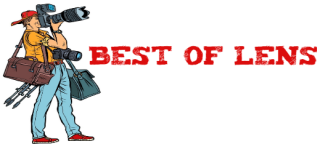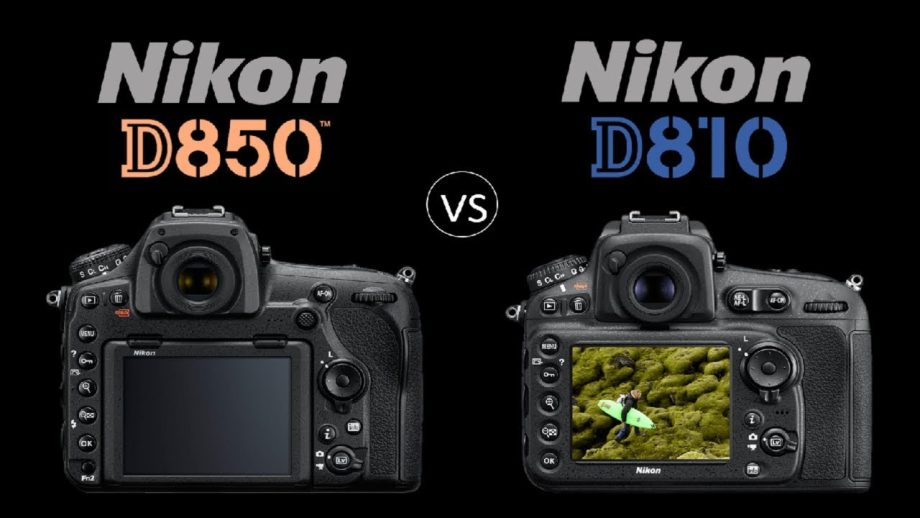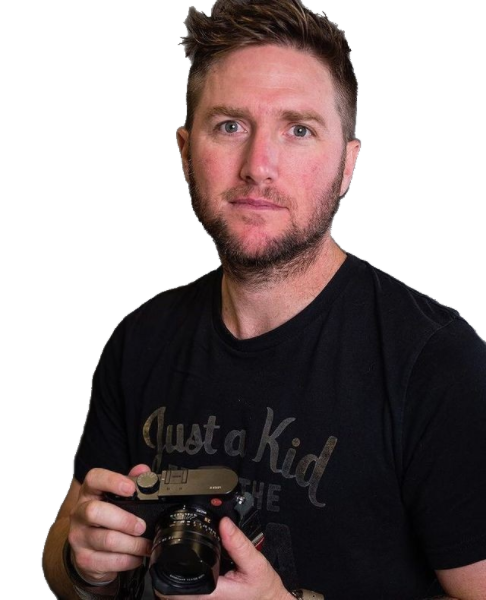Last Updated on December 7, 2023 by Sharon Advik
Nikon D810 vs. Nikon D850 comparison:
Overview:
My love and passion are photography.
A buddy of mine took the initiative in the business sphere.
She was showcasing her apparel line with echo-friendly content.
She asked me to photograph her brand.
I decided to film on a tight budget, which was only feasible on the streets.
I used my two cameras, a D850 and a D810.
The photoshoot for her apparel line was successful.
I received several requests from other photographers asking me to share the equipment I used for that street-based shot.
I’ll contrast the Nikon D850 and D810 Advanced DSLR cameras in this review.
Nikon D810 was released in June 2014, and Nikon D850 was released in August 2017.
D850 and D810 are three years apart. Let’s see if the two cameras’ different ages significantly impact.
I expect this to be a close match-up because both models ranked among the best in Advanced DSLR cameras.
With the introduction of its new high-resolution D850 DSLR, Nikon has pleased and delighted many photographers (opens in new tab).
Should D810 users rush to sell their cameras, though?
Or would it be preferable to continue using the previous model?
The camera’s recent debut was an excellent way to commemorate the company’s 100th anniversary.
First, I will generally discuss the specifications of these cameras.
Nikon D850 Key Specifications |
Nikon D810 Key Specifications |
| Announcement Date: 2017-08-24 | Announcement Date: 2014-06-26 |
| 46MP – Full-frame BSI-CMOS Sensor | 36MP – Full-frame CMOS Sensor |
| No Anti-aliasing (AA) Filter | No Anti-aliasing (AA) filter |
| ISO 64 – 25600 (32 – 102400) | ISO 64 – 12800 (32 – 51200) |
| Nikon F Mount | Nikon F Mount |
| 3.20″ Tilting Screen | 3.20″ Fixed Type Screen |
| Optical (Pentaprism) Viewfinder | Optical (pentaprism) viewfinder |
| 7.0fps Continuous Shooting | (Continuous shooting) 5.0fps |
| 4K (UHD) – 3840 X 2160 | Full HD – 1920 x 1080 |
| Built-in Wireless | Built-in Wireless |
| 1015g. 146 x 124 x 79 mm | 980g. 146 x 123 x 82 mm |
| Weather Sealed Body | Weather Sealed Body |
| Replaced Nikon D810 | Replaced Nikon D800 |
Let’s read the following parts to learn more about how the Nikon D850 and Nikon D810 compare in-depth and, perhaps, come away with enough justifications to choose which is best for you.
Physical Specification and Body Comparison:
When looking for the best camera for my professional shoot purposes, size and weight play a significant role in my selection.
In this part, I compared the front, rear, and top views of the Nikon D850 and Nikon D810 to show how the two cameras compare regarding their respective sizes.
The Nikon D850 is 1015 g (2.24 lb / 35.80 oz) in weight and is 146 x 124 x 79 mm and 5.75 x 4.88 x 3.11 externally (including batteries).
The Nikon D810 is 980 g (2.16 lb / 34.57 oz) in weight and has an exterior measurement of 146 x 123 x 82 mm (5.75 x 4.84 x 3.23′′).
Weight Comparison:
Another crucial consideration is weight, particularly when choosing a camera you’ll carry all day.
Although the Nikon D810 weighs 35g less than the Nikon D850, we don’t believe this will significantly alter performance.
Also, keep in mind that when comparing two interchangeable camera bodies, being a professional photographer, the body weight of the camera is not the only thing to consider; you must also consider the lenses you will be utilizing with these cameras.
The Nikon D850 and Nikon D810 have Full frame-sized sensors and an identical Nikon F lens mount, so lenses will not decide the system’s overall size.
Handling:
The D850 and D810 are essentially comparable in terms of ergonomics.
Both feature a sizable, sculpted handgrip, although the D850 was slightly more polished and pleasant.
Additionally, both feature a clean layout with a row of controls on the left side of the top plate, additional buttons below the screen, and twin input control knobs—a few modest but insignificant adjustments to the button locations.
For example, the Mode button now sits just beneath the shutter release, putting the D850 in line with the D5, D500, and D7500—a tiny joystick’s addition to the D850 to adjust the AF position.
Instead of five buttons, it has six buttons to the left of the LCD, with an Fn2 button at the bottom.
Image Quality:
Quality of pictures is the primary demand of every professional photographer like me.
The massive resolution was listed as a standout feature on both cameras.
Although the D850’s 45.7Mp surpasses the D810’s 36.3Mp, despite being a respectable improvement, the D810 does not immediately render obsolete.
Since neither camera has an optical low-pass filter, they can produce enormous, highly detailed prints—the D850 triumphs, in this case.
The D850 has a slight one-stop advantage over the D810 in terms of ISO range (64-25,600 vs. 64-12,800).
It can increase in both situations to a minimum of 32.
The D810’s maximum resolution was enlarged to 51,200 at the top.
Still, like the D850’s stop-extra 102,400, this is a purely theoretical difference since no one who values good image quality would ever approach it.
Since the D850’s new back-side backlit sensor has higher light-gathering capacity despite having the same size and number of pixels as the previous model, it should provide superior performance at equal ISO settings.
The exposure sensor has also changed, with the D850 featuring nearly twice as many pixels as the D810 (180K versus 91K).
Weather Sealing:
As I had described, it was an outdoor clothing brand shoot.
These were perfect decisions to go through harsh weather conditions.
I still would be able to shoot my task amazingly.
Weather sealings are built into the bodies of the D850 and D810, making them impervious to moisture and dust.
For experts, it is the most proper function a camera can offer.
LCD Screen Size and Features:
The Nikon D850 and Nikon D810 LCD panels have the same 3.20″ diagonal dimension.
While the Nikon D810 has a fixed-type screen that offers less flexibility in shooting positions than the Nikon D850, the Nikon D850 has a tilting screen that allows you to modify the angle of the screen to make it easier to shoot from the waist or over the head levels.
Burst Shooting:
- Seven frames per second for the Nikon D850 (up to 9fps with optional grip)
- Five frames per second for the Nikon D810 (up to 7fps with optional grip and DX crop)
The D810 is a capable full-frame DSLR with a hefty 36MP that is only three years old.
It can shoot continuously at a rate of up to 5 frames per second, and when a battery grip is attached, that rate increases to 7 frames per second (in a DX crop mode).
With a typical maximum burst rate of 7 frames per second (fps), which can be boosted to 9 fps when the camera is used with a battery grip, the new D850 does provide a tiny edge over this.
While seven frames per second is acceptable, there’s no denying that the D850’s higher rate increases the likelihood that photographers will get “that” ideal moment, mainly when photographing sports or wildlife when time is crucial.
Compare features:
Cameras may differ across many attributes in addition to Body and sensor.
The D810 and the D850 include an optical viewfinder, making them comparable.
Even in areas with intense lighting, the latter helps generate a clean image for framing.
Both CA cameras have the same field of vision (100%).
Still, the D850’s viewfinder has a greater magnification (0.75x vs. 0.70x), making the size of the transmitted picture look closer to the extent perceived with the unaided eye. Some other key characteristics of the Nikon D810 and Nikon D850 are included in the accompanying table, along with comparable details for several competitors.
One distinction between the cameras is the presence of an inbuilt flash.
The D810 has one, while the D850 does not.
Despite not being exceptionally bright, the D810’s built-in flash occasionally acts as a fill-in light.
There is an intervalometer on both the Nikon D810 and the Nikon D850.
The photographer may capture time-lapse images of phenomena such as flower bud formation, a sunset, or the moon’s rise without investing in an external camera trigger and
related software.
Sensor Comparison:
The Nikon D850 contains an Expeed 5 engine and a 46.0MP Full frame (35.9 x 23.9 mm) BSI-CMOS sensor.
The Nikon D810, on the other hand, comes equipped with an EXPEED 4 CPU and a 36.0MP Full frame (35.9 x 24 mm) CMOS sensor.
In real-world situations, the Nikon D850’s sensor offers 10 MP greater than the Nikon D810’s sensor.
I would say that your photographs may be printed more oversized or cropped more easily.
However, please remember that resolving power is not only determined by the maximum sensor resolution.
The optical components and sensor technology all impact the picture’s ultimate solution.
The lack of anti-alias (Low-Pass) filters on the Nikon D810 and Nikon D850 sensors is another commonality between these cameras.
While removing the anti-alias filter improves sharpness and detail, it also increases the likelihood of more in some scenarios.
Comparison of available lenses:
In this instance, 316 native lenses are accessible as the Nikon D850 and Nikon D810 share the same Nikon F lens mount. These lenses all accommodate Full-frame sensors.
The presence of picture stabilization is another crucial issue.
Because these bodies lack sensor-based image stabilization, you must purchase lenses with optical stabilization features.
There are 107 lenses with image stabilization for the Nikon F mount.
| Lens Type | Nikon D850 lenses | Nikon D810 lenses |
| Standard Zoom | 33 (17 Full Frame) | 33 (17 Full Frame) |
| Standard prime | 22 (19 Full Frame) | 22 (19 Full Frame) |
| Wide-angle Zoom | 33 (17 Full Frame) | 33 (17 Full Frame) |
| Super Zoom | 30 (6 Full Frame) | 30 (6 Full Frame) |
| Macro Prime | 26 (23 Full Frame) | 26 (23 Full Frame) |
| Telephoto Zoom | 54 (44 Full Frame) | 54 (44 Full Frame) |
| Telephoto Prime | 46 (45 Full Frame) | 46 (45 Full Frame) |
| Wide-angle Prime | 50 (48 Full Frame) | 50 (48 Full Frame) |
| Wide angle fisheye Prime | 8 (3 Full Frame) | 8 (3 Full Frame) |
| Perspective Control Prime | 11 (11 Full Frame) | 11 (11 Full Frame) |
| Telephoto Mirror Prime | 1 (0 Full Frame) | 1 (0 Full Frame) |
| Total | 316 (233 Full Frame) | 316 (233 Full Frame) |
What types of Photography are Nikon D850 and Nikon D810 Good for?
In this section, I tried to rank and contrast the Nikon D850 and Nikon D810 in five photography categories to help you choose if you are interested in one or more of these fields.
Portrait Photography:
The portrait is my favorite form of photography.
As I told you, I used it for my friend’s clothing brand shoot with the Streets theme.
I would say they had met my expectations.
I got terrific portraits of my models with their help.
Nikon D850 and D810 were GOOD choices for this style of photography, with a score of 69 for Portrait Photography.
Most of your demands will be met by the Nikon D850, but if you want something even more suited to portrait photography, check out the Both have excellent large Full frame (35.9 x 23.9 mm) sensors with a very High-Resolution Sensor of 46.0MP.
They have a fantastic Optical Built-in Viewfinder. Good Ergonomics and handling assist me in capturing my aesthetic portrait shots.
The only thing lacking in it was that it has no Image Stabilization.
Daily Routine:
Weatherproofing is a massive benefit for a camera I carry with me everywhere.
Both helped me in shooting that clothing brand. Compared to smaller sensors, the Nikon D850’s large sensor enables good low-light image quality, shallow depth of field, and a lovely fuzzy background when required.
It has a large Body.
Using even the smallest lens when mounted to this Body—1015 g of D850 and 980g of D810 will be challenging.
You might not feel very comfortable carrying this weight all day long.
They both are not pocketable cameras due to their thickness.
Long exposure photography:
Remember that there are no significant changes in the image quality generated by these two cameras before you sell your D810 in favor of its successor’s better ISO capabilities and a more substantial number of megapixels.
It would help if you stuck to the lower ISO levels because both cameras create noise at high ISO settings, even though the D850 has a broader ISO dynamic range and superior image quality at high ISO.
It will be challenging to distinguish any changes in image quality at the low end of the ISO range because both cameras provide comparable results.
Street Photography:
Why is street photography so popular, especially among younger people?
A blast to the max!
They come as a surprise.
All choices are therefore available.
A terrific time may be had, at least most of the time, by combining it with mingling with people on the street.
Even when you leave the roads, street photography is exciting.
The Nikon D850 and D810 were GOOD choices for this kind of photography, scoring 66 for Street Photography.
Most of your demands will be met by the Nikon D850, but if you want a camera that is even more suited to street photography.
I wanted to make my models look like regular people going to the office.
These gadgets nailed it.
Since it is closer to the Body, using a viewfinder during a street photography shoot lets me steady the camera and lessen camera shaking.
Additionally, it is helpful when LCD panels are challenging to read in direct sunlight.
In street scenarios, when you want to focus on a face, the face detection focusing mode is quite helpful since it allows me to concentrate on framing and other changes while the camera takes care of the focus.
Landscape Photography:
I had previously used it for a landscaping project.
My favorite landscape project I finished with its aid was Cliffs of Moher, Ireland.
It makes fine focus adjustments; a live view is more accurate than a viewfinder.
The Nikon D850‘s big sensor ensures good low-light image quality and delivers better pixel quality than smaller sensors.
The Nikon D850’s 46.0MP sensor is perfect for taking landscape photos.
The photographs will be more detailed if I print them out larger since I can do outdoor landscape photography in all weather conditions.
Nikon D850 Pros & Cons:
Nikon D810 Pros & Cons:
Benefits of the Nikon D810 include:
- A simpler fill-in has a tiny inbuilt flash to illuminate dark regions.
- More drastically reduced has been around for much longer (launched in June 2014).
Why is D850 a better shooter?
I recommend this to all to create a timeless memory or picture.
With its impressive 45.7 effective megapixels, this camera has mastered the art of clear images.
Its increased resolution makes it suitable for high-quality large-format posters and canvas prints.
Increased sensitivity and adaptability in various conditions are also made possible by an ISO range of 64 to 25600.
Even when you are outdoors exploring, always shoot in the best light.
For the most incredible tones and exposure, especially when using natural light sources, the Nikon D850 offers a wide range of color temperatures.
Outdoors, the natural light auto setting provides a more precise white balance, resulting in more vivid colors that pop out in my every shot.
The camera offers dependable radio-controlled remote flash shooting with a Nikon SB-50003.
You can rely on reliable flash control that gives you greater mobility no matter what stands in the way of your Nikon D850 and the Nikon SB-5000.
With all these fantastic features, I consider it to be a better shooter.
Conclusion:
The ultimate winner of this comparison is the Nikon D850.
It outperforms the Nikon D810 in all categories but one portability and has a higher overall score.
However, the size disparity between these cameras is slight in the real world.
Therefore, the Nikon D850 is not much at a disadvantage.
The D810 is still a highly capable DSLR, even if it is three years old, and meets the needs of many seasoned landscape and wedding photographers.
If all you capture are still shots, you might be better off staying with the D810 for another year or two until costs for the D850 start to decline.
It produces high-quality photographs that are rich in color and detail.
For most enlargements or the requirements of publications and stock libraries, 36MP is more than enough resolution.
I always recommend those items that work amazingly for me. And it saved my friend’s day.
She told me it was a huge success all because of that shoot.
Her dresses speak in my picture due to these Nikon magical devices.
Go and grab the gadget that suits your requirements.
Related posts:
Nikon Z5 vs. Nikon Z6 Comparison
I am a Professional and Certified Digital Photographer born in the USA. I have been in this field of photography for 22 years, and in these years, I have used many photography lenses and Cameras, which I want to share here on this website about my experience. The idea for Bestoflens.com is to provide honest information about different Lenses and Camera products in the format of a “Best lenses for AYZ” list. I want this website to be the last destination for people to pick the best Cameras and lenses to fit their needs. You can find our unbiased reviews here on Bestoflens.


